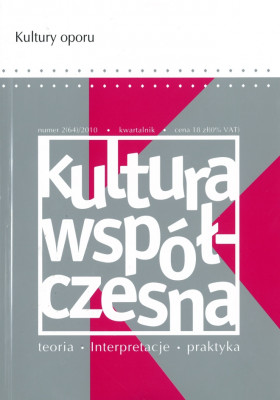Settings and search
Kultury oporu


Not every resistance in culture finds sufficient means to transform into the culture of resistance, not all subversive strategies have a chance to become an alternative political, scientific, artistic practice. Cultures of resistance can exist only where the critical thought develops. Such is the difference between them, the social movements and the identity of resistance. Seemingly they deal with the same subject matter – the mechanisms of power, symbolic violence and consumption, however in cultures of resistance a critical and a conceptual factor move to the foreground. The status of critical theories, political localisation, and undertaken anthologies may differ. Nevertheless, basic decisions – the “ability of knowledge,” will to question, conviction of subversive power of cultural practices – remain common. Subversive subjects remain sceptical towards any transcendental justifications, thus they are obliged to produce their own ones; not only within dominant symbolic orders but also within valid orders of knowledge.
The author attempts at answering the question what can be subversive and critical in the world of late capitalism, which has learnt to include and creatively use attacks, directed against it. Following Antonio Negri and Michael Hardt the author rejects an opposition inside/outside of the system and in accordance with Marx’s intuition, offers a search for efficient forms of resistance at the very centre of capitalist economics. He also points to political economy as a sphere most important for a criticalsubversive discourse. In agreement with the postulates of Alain Badiou and other philosophers associated with the political left, he stresses the possibility of the universalisation as an indispensable aspect of subversive theory and practice.
The article concentrates on three major issues. Firstly, on the issue of real effectiveness of the cultures of resistance in the process of leaving a permanent trace on the architecture of the collective order. Secondly, on the issue of difficulties with finding such a methodological and a research strategy that allows for better than so far analysis of the culture of resistance. Thirdly – it attempts at imagining others than today dominating strategies of cultural resistance. It takes into consideration activities and initiatives directed at suppressing further de-socialisation and fragmentation of society.
The article is devoted to an attempt at proving that traditional forms of resistance based on spectacular protest are ineffective inasmuch as they inscribe into the needs of contemporary capitalist system, and especially into its expectation of the new, medial and distractive. What is being proposed here is a new look on resistance; resistance treated mostly as these forms of opposition towards the system which (1) are undertaken by choice (and not by habit or lack of other possibilities), (2) lead to change enabling fuller self-realisation and expansion of the range of alternatives available to an individual, as well as (3) those whose essence is not to create spectacular messages directed at drawing attention to a particular problem. In its meaning proposed here, resistance refers to discreet activities but more effective because based on acting without the system, to immobilising its particular functions, to building of separate from the dominant (i.e. the one produced by capitalist system) the world of things. Its autonomy rests in the fact that the objects cease to be signs and means of expression and instead become first of all and again the tools. A way in which those who practice this particular form of discord treat them could be described by few adjectives: caring, individualised, instrumental. These are oppositions towards the notion describing relations with material objects preferred by the capitalist system: brutal, equivalent and semiotic. Based on such relations with objects, resistance is effective inasmuch as it not only ignores the core of the capitalist system – i.e. production and distribution of objects accompanied by production of meanings regulating social life – but also because its character is continuous, it becomes included into everyday activities and becomes a way of being in the world and not an occasionally performed spectacle directed at its change.
Subversion – a term which at least since 1980s systematically becomes more and more popular in the humanities, mostly owing to art theory and critique, poststructuralist critique of subjectivity and performative studies – is used in this article to describe practices known as artivism, i.e. situated on the threshold between street art and urban activism: subvertising, graffiti and stickers. In an analysis of the work of two street artists: Darius Jones (Leon Reid IV) and Brad Downey, application of this term and, more broadly, the concept of the subversive allows for an explanation of an ambiguous position of similar practices in the urban culture. This term allows first of all, for the description of activities which consciously evade the well known dichotomy: dominant culture – culture of resistance. Subversion is a form of intera-systemic critique assuming the use and “subversion” of the elements of culture which are subject to questioning. It allows however to grasp much more difficult to describe process of “re-formatting” (notion introduced by Rafał Drozdowski), that is, creative construing and processing of identities of the participants of these practices by the “use” of the city: its signs, places and objects.
The article discusses the Corb 2.0 project, by an Australian architect Andrew Maynard, inspired by the work of Le Corbusier among others. Maynard’s utopian project is analysed here as an example of “aleatoric architecture” governed by the rule of chance. Such a perspective finds its predecessors in the Situationist manifesto Formulary for a New Urbanism by Ivan Chtcheglov and Odo Marquard’s “philosophy of chance.” Corb 2.0 is presented here as an idea with a crucial educational dimension, stressing the role of risk and chance in contemporary culture, and at the same time, an example of the dialectic of two “cultures of resistance” inscribed in the architectonic idea. The first one is essentially modern “culture of resistance” against the category of alea, accidental character of the fate and mysterious future, with the desire, typical for this culture, to rule over the future by the force of scientific laws and rational reason allowing for an insight into the nature of things and future trajectory of events. The second one is postmodern “culture of resistance” against the first one expressing opposition towards cognitive optimism, purposeful rationality and specialist’s certainty.
The aim of this article is to describe the phenomenon of (post)modern antimatter and an attempt at initiating a reflection on its “social adequacy.” Generally speaking, it deals with the fact that the spaces of the lives of contemporary people to a larger extent are filled with objects and constructions whose sensorily-perceived qualities question the “essence” of these objects and constructions. A perfect example of antimatter are glass stairs, where the function of “holding-confiding” is being realised with the use of the material that is a synonym of delicacy and fragility. A reflection of the phenomenon of antimatter almost automatically provokes a question about a sanction for the “transgression” (the matter of things, fragment of the world, common sense): is antimatter simply a not serious materialisation of today’s way of “human being inhabiting the world” or is it something essentially autonomous towards the human being, alienating, creating distance between her/him and the environment of their life?
The article frames the oeuvre of the artistic duo KwieKulik (Sofia Kulak and Przemysław Kwiek) through the prism of their social and political engagement and an open critique of surrounding reality undertaken by them, which remain without precedence in the history of post-war central European avant-garde. KwieKulik, the students of Oskar Hansen at the turn of 1960s were the first who gave his Open Form radically political dimension. The look at the oeuvre of KwieKulik – also owing to the tolls provided by contemporary theories of Badiou, Negri, Žižek and others – twenty years after the political transformation allows moreover for rethinking of our attitude towards the socialist past. It allows for separation of non-democratic and repressive communist state from emancipatory character of collective and socialist ideas represented by KwieKulik.
In the world of Web 2.0. where both the information and channels of its transmission are diffused, and where the access becomes mobile, a look at the problem of resistance sometimes meets risks the danger of generalisation. It is the result of more discreet forms of surveillance or of the creation of the atmosphere of threat causing self-censoring. All these activities influence the sphere of art. One can observe the use of “guerilla” tactics by the artists-activists using the Internet and mobile communication media (inverse engineering, locative media). If Wikipedia is a set of knowledge resembling encyclopaedia, created with the participation of a big number of authors but without a superior editor, it can be considered a model of activity developed by alter-globalist and alter-cultural activist.
The aesthetics of small white cats is a good point of departure for tracing of an ambiguous presence of cuteness in popular culture, and in a parallel way – for a reflection on the meaning, logic and capacity of the category of cultural resistance. Cuteness is treated here as both an object and a tool of subversion, while resistance refers to Situationists’ detournement, as well as to the resistance to changes. Owing to the crossing of these two spheres there emerges an interpretatively fertile – and at the same time problematic – space where one could try to answer the following question: could Hello Kitty be jammed?
The article offers a reflection on urban communities of resistance understood as heterogenic nonidentificatory coalitions organised in response to the control of the right to the city and its gradual commodification. Taking as a point of departure the theories of Jacques Rancière and Chantal Mouffe, the author claims that the postpolitical character of the neoliberal metropolis is a consequence of the displacement of conflict inspiring elements “essential” for the urban politics. A theoretical proposition aimed at negotiating these conflicts, equivalent to politicisation and democratisation of the urban space is the concept of multitude of Negri and Hardt. Interpreted in the categories of localised multitude it allows, according to the author, for the culturing of the right to the city and its effective execution in the place of the subject of resistance privileged by Lefebvre – namely the working class.
The author concentrates on the analysis of game farming, i.e. earning real money by the players who trade virtual objects and/or provide commercial services in the world of computer games. He attempts at presenting this phenomenon in a broader perspective related to the transformations of contemporary economy and the character of contemporary capitalism. Particular attention is being directed at the blurring of traditional distinctions between work and play, which is connected to the postmodern character of contemporary culture and dialectic overcoming of the contradictions of capitalism.
Ambient Intelligence (AmI), i.e. intelligent environment – a technological project which has a chance to be introduced in the next 10–20 years – is supposed to be an interactive network of miniature electronic devices, communicators and everyday objects “immersed” in the environment. While the “technical” side of this phenomenon can be to a large extent imagined and predicted, further consequences of the development of the “intelligent environment” exceed our contemporary cognitive horizon. The article presents in brief main characteristics of the AmI, hopes relating to it (immense possibilities as far as practical improvements, safety and the protection of health are concerned) as well as the most important spheres of threats (privacy, identity, safety, trust, exclusion). In the next part of the text, referring to, among other things, the analysis proposed by Cecile K.M. Crutzen, crucial lacks in the mainstream of the reflection on the intelligent environment are being pointed at. Ethical requirements – as shown by already mentioned critique of the AmI – point to the need for transparency, “unhandiness” of the system, therefore, are aimed at that which is supposed to be the greatest advantage of the AmI: its immersion into environment and “invisibility”.
